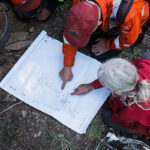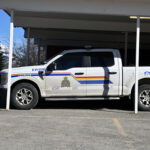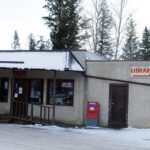Home »

CFES to continue launching EMR service
Ambulance Paramedics and Emergency Dispatchers of BC want the City of Cranbrook to leave emergency medical response (EMR) services in its hands, a union spokesperson related during a presentation to council last night (Sept. 17).
The presented request followed a city council ask of Cranbrook Fire & Emergency Services (CFES) last year to look into and implement an emergency medical response service.
 Cameron Eby, Ambulance Paramedics and Emergency Dispatchers of BC – CUPE Local 873, with the BC Ambulance Service (BCAS), told council there are currently 34 paramedics in Cranbrook, with five full-time working the day shift only and 29 on-call, working night shifts. There are three daytime and two nighttime ambulances.
Cameron Eby, Ambulance Paramedics and Emergency Dispatchers of BC – CUPE Local 873, with the BC Ambulance Service (BCAS), told council there are currently 34 paramedics in Cranbrook, with five full-time working the day shift only and 29 on-call, working night shifts. There are three daytime and two nighttime ambulances.
The Cranbrook crew handles about 2,300 “pre hospital medical calls” a year, not including hospital transfers, Eby said.
Noting concerns about BCAS response times, a key reason for the city having CFES members train for and deliver paramedical services, Eby said there has been an improvement in recent years due to the way BCAS classifies emergency levels and relates it to calls by using the recently implemented Clinical Response Model (CRM).
“Over the years there has been an under-funding of the ambulance service, which has led to staffing shortages and an over-reliance of on-call paramedic staffing. That translates into slower response times. So there has been an over-reliance built up over the years on local fire departments to provide first response services,” he said.
Eby said of the estimated $4.3 million budget for CFES, with 64% of its calls being “medical assist” means $2.75 million is being spent at the municipal level to do what provincial funding should cover.
Noting he realizes those figures over-simplifies things, Eby said he mentioned it because with $2.75 million a year in funding from the provincial government the local BCAS would be more fully staffed and capable to respond.
Eby said the city would incur additional costs such as training and maintaining training of CFES first responders to emergency medical responders, medical oversight and liability insurance.
“Everybody gets sued,” he noted.
Eby cited the City of Delta as an example of a municipality that began to lean on its fire department for medical first responder services in 2016.
A measurable outcome thus far is that fire department responders are “one minute, maybe two minutes” faster than BCAS.
That little bit of time doesn’t even allow the fire fighters to get into “diagnostic measurements” before the ambulance arrives.
“Overall there has been no evidence of better patient outcomes in Delta,” he said.
Additionally, t union sees the city and CFES taking on paramedical services “as a downloading from the provincial government,” Eby told council.
Continued categories and use of CRM will also lead to even better response times, he added.
And BC Emergency Health Services has been adding more paramedics in many areas of the province, including in Castlegar, Trail and Nelson, he said.
He concluded that all the services provided by BC Ambulance “come at no additional cost to municipalities.”

Noting the city appreciates the services provided by BCAS, Mayor Lee Pratt said, “we understand and sympathize with the funding the province is giving you. We believe you do deserve more funding and we would certainly support that for you if we can.”
However, some of the information provided by Eby was off, such as the $2.75 million cost figure to the city.
“That is totally wrong because those guys are working; they’re already there on shift. We looked at that we are just improving the efficiency of that department. Rather than have them waiting for something to happen fire-wise, they are there and they can respond and by all means we would use them.
“As far as the budget goes, I think we put in $45,000 for training. We came in under that and two of our officers are trained to give that continued education training, and they will do that while they are on shift, so we are not really adding any cost to that.”
As for insurance, the city is “still in negotiations on that,” Pratt said.
“The bottom line is we’ve made the decision. We want to do what we felt was right for the safety of our community,” he said, pointing out that BCAS’s 29 on-call paramedics have to be called in, “while our guys are sitting there waiting. That could be the difference; that one minute could save a life.”
In response, Eby said, “The fact of the matter is, what happens when the fire does happen? And the first responders are tied up on the medical call that isn’t a life threatening situation; that’s the complexity.”
He also noted that some municipalities have had to increase taxes “specifically” to fund first responders attending medical calls, citing Kelowna and Vancouver.
And if a medical call turns out to be a “life threatening thing, both agencies (BCAS and fire departments) are called,” Eby said.
Pratt replied that manpower considerations have been factored in by CFES.
If two responders depart the station for a medical call there are still enough fire fighters on shift to respond to a fire call, he said.
“This is not Vancouver or Delta or Kelowna; for fire calls we’re not even close to that league,” he said.
“The BC Ambulance provides a great service. In Cranbrook, we have an incredible crew of medics. But that doesn’t excuse the gap in service created by the provincial government,” noted Coun. Danielle Eaton.
“We enjoy a very positive and beneficial relationship with BC Ambulance. They’ve been wonderful to work with over the years and we are really happy to have that relationship with them, that benefits the community,” said CFES Acting Fire Chief Scott Driver following Monday night’s council meeting.
Driver said EMR training has been conducted and CFES staff is finalizing steps to “roll out that operationally,” which he estimated as in the next couple of months.
As for CRES members responding to non-life-threatening calls and a fire call coming in from somewhere in the service area, he said, “
Driver said he congratulates BCAS on implementing the CRM program.
“They have a new dispatch model and they believe it is sending their vehicles and their staff to critical incidents in a faster time.”
However, there are calls where response times are much greater than a minute or two, he said.
“As local government, our role is to address those outlying issues, whether it is 10, 20 or 30 minute waits for the ambulance. They’re not really frequent, it’s not a normal occurrence but it does happen almost predictably regular. In the last three months, with the new dispatch model, we’ve had one call per month that is over a 30-minute wait per call. So those are the incidents where the local government has the opportunity to provide a different level of care. And that is what this council has asked the fire department to do.”
CFES can now attend emergency scenes that BCAS cannot attend quickly and “provide care to our people.”
While there is a “little extra demand on staff time and cost,” having CFES members ready to go in terms of emergency medical services makes sense, Driver suggested.
“Those costs are so small compared to what our normal operational costs for the fire service are that the community would find it acceptable for the benefit they are receiving,” he said.
See the Ambulance Paramedics and Emergency Dispatchers of BC slide presentation to Cranbrook council.
Ian Cobb/e-KNOW







